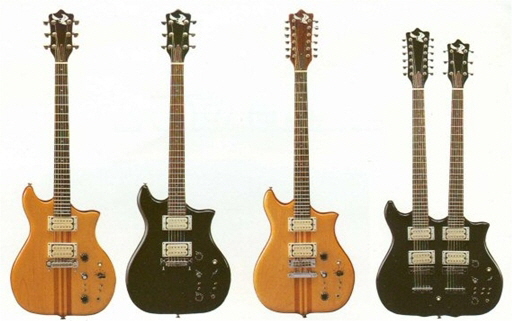The F Range
The F-I
It appears (not much is certain in Kawai land - there’s just no definitive information!) that the F series appeared after the KS range - which would mean early-mid 1980s.
This range included both real guitars (the odd numbered models) and bass guitars (the even numbers) All featured a thru-neck construction and some included a range of on-board electronics. That perhaps explains why they are sometimes compared to the Alembic bass guitars of the same period. The basses seem to be particularly popular in the USA - at least, that’s where I’ve seen most of them.
“From the top” ... The F-I was the top-of-the-range model (that’s my F-I on the left of this page).

As you might already have noticed, there were a number of variants of the F-I, including a 12 string and a double-neck version. There are some photos of the double neck in one of the owner’s galleries. Apparently, it’s just a little heavy!
Standard specification for the F-I included Dimarzio pickups and some active electronics, powered by the standard on-board 9V battery. This gave the guitar the following options;
- a pre-amp on-off switch
- a pre-amp level control
- a boost/distortion selector switch
- a varitone selector
- a coil tap switch
- a phase reversal switch
When I acquired my F-I. it came in a non-working condition, having suffered years of neglect. I had to completely re-wire it, which meant I first had to work out the circuit diagram! If any other F-I owner needs a wiring diagram, get in touch!
The F-I was also available as a Jr version, which again used the separate bridge and tailpiece as seen on the KS range. Interestingly, the F-I Jr was a fairly basis guitar, with none of the active electronics shown and detailed above.
Construction of these guitars was impressively complex. As well as the 5-piece thru-neck (Maple & Mahogany) each of body wings consisted of 3 separate pieces - a Maple cap front and back around a Mahogany core. These couldn’t have been cheap - or quick - guitars to make.
But they’re (of course) great to play!!
The F-III.
Next step down in the range was the F-III
Kawai continued to explore new possibilities with this guitar. The pick-up selector switch moved to the lower horn (just under the neck pickup) and rather than a standard 3-way, this was a 4-way rotary switch, the 4th position being a “stand by” position which presumably disconnected the on-board battery.
The mini-toggles on this guitar engaged a boost and distortion circuit. Each mini toggle had 3 positions; off, boost, distortion and each mini-toggle controlled one pickup.
Hence the bridge pickup could be switch to “off”, whilst the neck pickup was switched to “boost” for that cutting solo.
The rest of the controls were a fairly standard 2 vol, 2 tone.
Construction was slightly simpler than the F-I. Although the thru-neck remained, the body sacrificed the 3-piece constuction and was either Ash or Koa.
Note also the separate bridge & tailpiece.
 The F-V The F-V
And finally, at the bottom of the range, was the still rather impressive F-V.
This model retained none of the active electronics of its bigger brothers, but did retain the same construction approach and quality of materials used in the rest of the range.
The mini-toggles were coil taps for each of the pickups.
Each pickup also had its own volume control, but there was only a “master tone” control - hence the 3 knobs rather than more usual 4.
As well as the normal natural finishes (as shown above), for some strange reason, Kawai also decided to offer a number slightly brighter colour options. Called the “fruits colour”, you could also have your F-V in lemon, blue, cherry, melon or orange finishes.
I’ve never come across a fruit called “blue”.
And here’s a quick pic of my F-I models, sunbathing ...
|